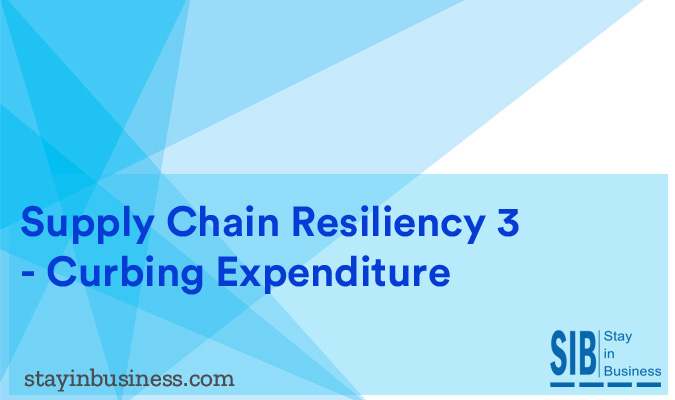
Curbing Expenditure
Adaptability will be crucial for supply chains to streamline interconnected workflows that span across various entities in a cost efficient manner. Asset utilization can be optimized through visualization and modeling techniques that allow SCM teams to design solutions after weighing out influential parameters such as expense, timeframe, quality, risks and more.
For instance, when a promotional campaign is underway, the storage levels, inventory threshold, delivery of additional quantities etc. are mapped to anticipated sales during and immediately after the campaign. Factors that could lead to excessive or insufficient demand are included. When the system data is approaching a spike in demand, the planning team is instantly notified and the appropriate operations are deployed to stock up on supplies. Transport and distribution options are evaluated automatically based on the amount of time available. Similarly, delays in delivery, quantity mismatches and other such operational glitches can be smoothed over by re-configuring specific segments of the supply chain.
Being Prepared
- Is the supply chain resilient enough to stabilize the impacts from fluctuations in expenditure?
- Can the supply chain network’s design be customized so that expenditure can be brought in sync with revenue?
- Is expenditure on interconnected systems that connect different and disparate business entities monitored and maintained at an optimal level?
Curbing Expenditure through Machine Aided Strategies
- Use of sensor devices to bring down storage expenditure and augment process perceptibility
- Process detectors that are deployed across production lines and distribution networks to manage waste and maintain consumption of utilities such as gas and electricity at an optimal level
- Eliminate losses and inaccuracies by incorporating smart technology based devices into operations
Curbing Expenditure through Connectivity
- An integrated framework that links different entities and components in the supply chain including providers, production units, business associates, legal and accounting services
- Facilitating price differentiation based on customer profile, order volume and market segment
- Improved efficiency through collaboration on activities such as decision making and planning
- Asset usage optimization
Curbing Expenditure through Data Driven Systems
- Assessment of workflows in commonly encountered situations
- Simulated analysis to gauge the supply chain’s adaptability based on various parameters such as service metrics, price, duration and storage
- Sustainable strategies that optimize consumption of resources such as gas, petrol, electricity, water and minimize the generation of wastes and residue
- Reduction of sales loss and missed opportunities by mapping demand with supply through knowledge sharing, strategic resource allocation and effective workarounds for storage constraints
Case Study
A military retail company caters to the needs of active, guard, reserve and retired personnel. Nearly 70% of the company’s earnings are directed towards outreach programs for the benefit of the personnel.
The company discovered that reduction in expenditure could be utilized to improve the services that are extended towards these individuals. As a result, the company was always on the lookout for strategies to curb their business costs. The parent organization of this company owned another company that catered to the same customer and had a similar corporate profile at a structural level. Both these companies decided to share their operational infrastructure in a bid to reduce costs and increase profits.
A team was put in place to identify operational segments in both the companies’ businesses that could be addressed through a consolidated strategy.
For instance, one company delivers products for processes conducted by the second company. The products are first moved to a storage facility owned by the second company before being transferred to its site. The costs involved in maintaining the storage facilities could be eliminated if the first company’s products were transported directly to the second company’s locations.
By employing such strategies, both the commercial enterprises could drastically cut down their expenditure on product delivery by scaling production. Storage expenses and manpower requirements could also be cut down.
See for yourself how the application works
Witness our cloud based platform’s security capabilities in action
Play around with the software and explore its features
Compare and choose a solution that’s relevant to your organization
Consult our experts and decide on a pricing mechanism
Disasters
[carousel id=’1780′ items=’4′ items_desktop=’3′ margin_right=’5′ navigation=’false’] [item img_link=”https://www.stayinbusiness.com/wp-content/uploads/2016/02/Chemical-Spills-Discharges.jpg” href=”https://www.stayinbusiness.com/resource/disaster-recovery/chemical-spills-and-discharges/”][item img_link=”https://www.stayinbusiness.com/wp-content/uploads/2016/02/Riots-Public-Disturbances.jpg” href=”https://www.stayinbusiness.com/resource/disaster-recovery/riots-and-public-disturbances/”][item img_link=”https://www.stayinbusiness.com/wp-content/uploads/2016/02/Terrorism.jpg” href=”https://www.stayinbusiness.com/resource/disaster-recovery/terrorism/”] [item img_link=”https://www.stayinbusiness.com/wp-content/uploads/2016/02/worst-product-recall.jpg” href=”https://www.stayinbusiness.com/resource/disaster-recovery/product-recall/”] [/carousel]
